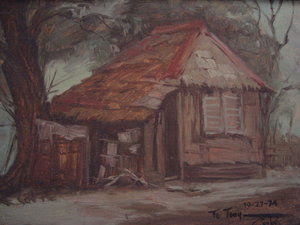 For many years now, my wish list of paintings includes that of the relatively unknown and underrated artist from Cavite, Simon Saulog. I first saw his work included in Filipiniana art collection of Jorge Vargas, and later read about his life in a past issue of Art Manila. He was an acclaimed painter in the 1950s, famed for his paintings of Filpino madonnas--only to die almost forgotten in his home province in November 1995.
For many years now, my wish list of paintings includes that of the relatively unknown and underrated artist from Cavite, Simon Saulog. I first saw his work included in Filipiniana art collection of Jorge Vargas, and later read about his life in a past issue of Art Manila. He was an acclaimed painter in the 1950s, famed for his paintings of Filpino madonnas--only to die almost forgotten in his home province in November 1995.Born in Malagasang in Imus in 1916, Simon exhibited extraordinary talent at a young age. Father Juan Saulog, a horse trader, would often find him sketching horses as Simon sat by their house’s ventanilla. The proud father would show his son’s sketches around, who, in turn would be amazed at his artistry.
 His first mentor was a 17 year old neighbor, Gregorio de los Santos, who would watch him copy the likeness of Rizal from a very small postage stamp. Simon would follow suit—but he copied Rizal’s image from a bigger one peso bill.
His first mentor was a 17 year old neighbor, Gregorio de los Santos, who would watch him copy the likeness of Rizal from a very small postage stamp. Simon would follow suit—but he copied Rizal’s image from a bigger one peso bill.Saulog enrolled at the University of the Philippines in 1931. When Fernando Amorsolo, Fabian de la Rosa and art teacher Candido Alcantara saw him draw, they described him as “isang pintor sa puso” ( a painter at heart). While in school, Saulog was won two medals and 8 honorable mentions for his works. He graduated in 1936, together with his classmates that included Angel Luna, Cesar Legaspi, Victor Loyola and Ricarte Purugganan.
Thereafter, he joined many art competitions, and it was in the post-war contests of the Art Association of the Philippines that his “Filipino Madonnas” first created a stir. They were described as “women of unspoiled, fragile purity, ideal of the countryside”.These qualities were the hallmarks of his works, and he belive that an artist does not paint sceneries, but paint stories.
Saulog, in his lifetime, won many awards, including taking second place for his painting “Offspring” in 1952. In 1956, he won first place in a UNESCO-sponsored art conest in New Delhi, India. He served as judge at the Shell Art Competition and exhibited his works in Bern Switzerland.
In 1955, he also exhibited at the first sidewalk art of the Academy of Filipino artists and was featured in the First Southeast Asian Art exhibition in 1957. His works were soon available in the numerous galleries that dotted Mabini St. in Manila.
When a new breed of modernist artists emerged to take his place, Saulog went back to Cavite to work—and teach-- in obscurity. He suffered from poverty, remaining unnoticed in death. De La Salle University-Dasmariñas was the first to take note of Saulog’s contribution to Philippine art, celebrating his silver jubilee with an exhibit of his works at the Museo De La Salle. Despite this renewed awareness, Saulog paintings are rare and hard to come by in the market.
The first Saulog painting I saw for sale was in one uppity antique shop in a Manila mall. The second one was a beautiful pastel of a guitar-playing old man puffing a cigar at Galeria de las Islas in Intramuros. I was told there is a Saulog currently available at Tiendesitas for Php 45,000.
A local painting warehouse in Cubao yielded a more recent Saulog watercolor dated 1981 with a 35K price tag. The painting is entitled "Mariang Makiling.
An early Saulog portrait of an American woman is also up for grabs on ebay with a starting bid of $399—but there are no takers yet. The alien subject may be undesirable to many collectors.
It was a surprise then to see a small Saulog piece offered on local ebay Philippines at a very reasonable price. It is a small piece, 12 x 17”, signed S. Saulog, “Imus, Cavite”, a signature tribute to his town and province.
The circa 1970s painting was dedicated to a certain Tony ( a lawyer-patron, I was later told), and it came from a private collection of an art-loving couple who have been silently unloading some other vintage pieces from their collection that included Anchetas, Laxas, Navarros, Custodios and J.D. Castro. Although bidding is slow on ebay.ph, bidders snapped most of the choice paintings.
As it turned out, I was the only bidder of the Saulog work, which was priced more than the Custodio and the Laxa pieces, but still within my budget.
Now, I am a proud owner of a Saulog painting, a small treasure as colorful and as affecting as the life lived by Cavite’s art maestro and, more importantly, a legacy that will ensure that he will always be remembered and never forgotten.








Nice!! Have a couple original purchased by parents in Philippines in60's they want to sell
ReplyDeleteCan you help?
Dohron@yahoo.com
Kindly like: https://www.facebook.com/SimonSaulog/
ReplyDeleteWhat was his birthday date?
ReplyDeletewhat are the materials used for painting?
ReplyDeleteThanks for sharing this information.
ReplyDeleteLifeguard training
I really appreciate the time and efforts you've clearly put into this post. Lifeguard training in Broome County
ReplyDelete